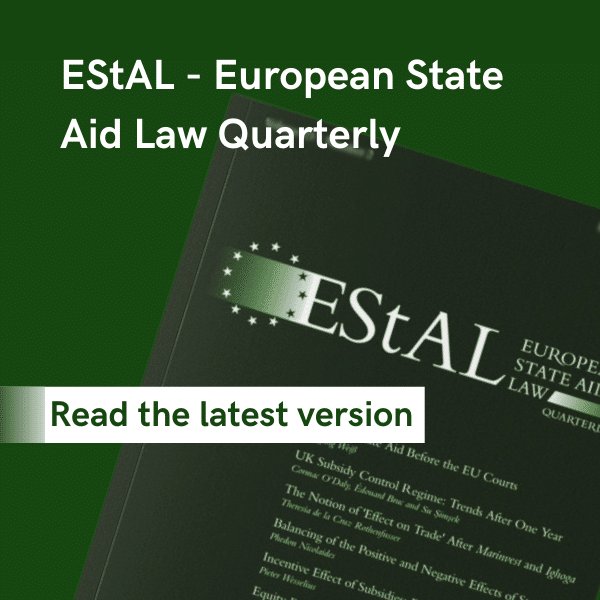
The new RDI Framework provides continuity with clarity.
On Monday, 19 April 2021, the European Commission published the new Regional Aid Guidelines for the period 2022-2027. They can be accessed at:
https://ec.europa.eu/competition/state_aid/regional_aid/RAG_2021_adopted_communication.zip
Introduction
On 8 April 2021, the European Commission published the text of the draft new RDI Framework and launched public consultation.[1]
The draft RDI Framework is accompanied by an Explanatory Note which summarises the findings of the fitness check evaluation of several Commission guidelines, including those on RDI.[2] The fitness check found that on the whole the RDI rules were fit for purpose and that stakeholders wanted the rules to remain stable after the “steep learning curve” following the State Aid Modernisation that was launched in 2012 and fully implemented with the current rules that were adopted in 2014.
However, according to the Note, feedback from stakeholders also indicated that some aspects of the RDI rules needed clarification, simplification and updating to reflect evolving technological and market conditions.
Given that most RDI aid is granted on the basis of the GBER and that the RDI Framework is rarely used, the value of the proposed revisions lies not so much in simplifications or new definitions but in the clarifications of what is not State aid [i.e. aid to research organisations] and how the compatibility of aid is to be assessed. The draft RDI Framework is the first of the new generation of guidelines with a different configuration of the compatibility principles.
The Explanatory Note summarises the major changes in the RDI Framework as follows:
Clarifications
- Digital Innovation Hubs under the Digital Europe Programme may qualify as innovation clusters. However, this does not change the scope of application of the current definition in State aid rules.
- Digitalisation related RDI can qualify as industrial research, experimental development, as well as process and organisational innovation Even if not expressly referred to in the current definitions, digitalisation related R&D and Innovation activities are already covered implicitly by the existing definitions.
- Innovation activities of SMEs: The current definition is elaborated so that it covers more IT, software development, artificial intelligence and other digital technologies.
New definitions
They are introduced to allow support for technology infrastructures and to incentivise RDI on digital and green transition.
- According to the explanatory note, “contrary to research infrastructures, technology infrastructures are intended to be predominantly used by industry, in particular SMEs to address the lack of relevant closer to market testing facilities of new untried technologies to finalise their development before market introduction.”
- For technology infrastructures, the definition is based on the one developed in the Commission Staff Working paper on Technology infrastructures.[3] This ensures terminology consistency between State aid and Horizon programme rules.
- Technology infrastructures will be supported in the same manner as research infrastructures limiting the support to investment costs. The aid intensity will be 25%, as the rate that is applicable to experimental development.
Revisions to reduce administrative burden
- Simplified methodology to calculate indirect costs of R&D projects: At present, the rules of the GBER allow Member States to use simplified cost options only when the project or activity is at least partially financed through a Union fund (e.g. Horizon, ESIF, etc.). In the future, the simplified cost options will be applicable to State aid for RDI.
- Ancillary activities: The new rules clarify that the monitoring of the ancillary character of the economic activities defined in paragraph 20 of the RDI Framework shall apply for a 10 year period. This clarification makes compliance with ancillary activities coherent with the 10 year prescription period laid down in the Procedural Regulation.
The main provisions of the draft RDI Framework
[Note to the reader. I quote directly from the draft Framework, but I do not use quotation marks to avoid cluttering the text. Therefore, to prevent confusion, my comments are in brackets.]
Scope
It applies to all sectors.
EU funding centrally managed by the institutions, agencies, joint undertakings or other bodies of the Union that is not directly or indirectly under the control of Member States does not constitute State aid [e.g. Horizon Europe or the Digital Europe Programme].
Aid for firms in difficulty is excluded from the scope of the Framework.
The Commission will take account of the amount of incompatible aid that has not yet been recovered [i.e. the so-called Deggendorf principle; see case T-244/93].
The Framework covers aid for:
(a) fundamental research, industrial research and experimental development;
(b) feasibility studies;
(c) research infrastructures;
(d) technology infrastructures;
(e) innovation activities;
(f) innovation clusters.
The Framework has a long list of definitions.
Non-economic activities
Where the same entity carries out activities of both economic and non-economic nature, the public funding of the non-economic activities does not fall under Article 107(1) TFEU if the two kinds of activities and their costs, funding and revenues can be clearly separated so that cross-subsidisation of the economic activity is avoided.
The following activities are generally of a non-economic character:
(a) primary activities of research organisations and research infrastructures, in particular:
(i) education for more and better skilled human resources;
(ii) independent R&D for more knowledge and better understanding, including effective collaboration;
(iii) wide dissemination of research results on a non-exclusive and non-discriminatory basis, for example through teaching, open-access databases, open publications or open software.
(b) knowledge transfer activities, where all profits from those activities are reinvested in the primary activities of the research organisation or research infrastructure.
Where a research organisation or research infrastructure is used for both economic and non-economic activities, public funding falls under State aid rules only insofar as it covers costs linked to the economic activities. Where the research organisation or research infrastructure is used almost exclusively for a non-economic activity, its funding may fall outside State aid rules in its entirety, provided that the economic use remains purely ancillary, that is to say corresponds to an activity which is directly related to and necessary for the operation of the research organisation or research infrastructure or intrinsically linked to its main non-economic use, and which is limited in scope. For the purposes of this framework, the Commission will consider this to be the case where the economic activities consume exactly the same inputs (such as material, equipment, labour and fixed capital) as the non-economic activities and the capacity allocated each year to such economic activities does not exceed 20% of the relevant entity’s overall annual capacity. The monitoring of the ancillary character of the economic activity shall apply for at least 10 years from the start of operations of the research organisation or the research infrastructure. In case the research infrastructure or the research organisation increases its economic activity so that it cannot be considered as ancillary, the public funding of the whole economic activity will fall under State aid rules.
[The underlined text is new. Unfortunately, it is not so clear what Member States are supposed to do. Should the “monitoring” ensure that the ancillary activity is linked to the non-economic activities of the research organisation? In a new footnote (no 34), that does not exist in the current RDI Framework, it is stated that “the research community, when conducting ancillary economic activities, derives improved and enhanced expertise and knowledge that can be used to perform the primary non-economic activities of the research organisation or the research infrastructure to the benefit of the society at large”. This is an excellent explanation of the reason why research organisations may want to engage in ancillary activities. It is not because they earn extra income but because by doing so they learn how the real world functions or how they can apply theory more effectively. This implies that the purpose of an ancillary activity is to test theory through practice, enhance skills or generate practical knowledge that can be used as input to further research. If this is a correct understanding of the purpose of ancillary activities, then the aim of the monitoring is simply to prevent research organisations from setting up commercial consultancy operations under the pretext of carrying out ancillary activities.]
[In this connection, the draft RDI Framework misses the opportunity to clarify the role of consultancy carried out by research organisations. Both the current and the draft Framework include consultancy in the definition of “knowledge transfer”. But knowledge transfer can also be carried out in the context of innovation clusters and innovation advisory services which are economic in nature. If consultancy, therefore, is an economic activity it is not clear why it is included in knowledge transfer activities which are non-economic in nature. More importantly, consultancy means a service that addresses the needs of a particular client and, therefore, is based on information provided by the client. The meaning of knowledge transfer in the case of research organisations is that they disseminate the knowledge they have created themselves for the benefit of society.]
Public funding of economic activities via research organisations
Where research organisations or research infrastructures are used to perform economic activities, such as renting out equipment or laboratories to undertakings, supplying services to undertakings or performing contract research, public funding of those economic activities is generally be considered tate aid.
However, the Commission will not consider the research organisation or research infrastructure to be a beneficiary of State aid if it acts as a mere intermediary for passing on to the final recipients the totality of the public funding and any advantage acquired through such funding.
Indirect State aid to undertakings through public funded research and knowledge dissemination organisations and research infrastructures
- The question of whether and under which conditions undertakings obtain an advantage within the meaning of Article 107(1) of the Treaty in cases of contract research or research services provided by a research organisation or research infrastructure, as well as in cases of collaboration with a research organisation or research infrastructure depends on whether the behaviour of the research organisation or research infrastructure can be imputed to the state.
Where a research organisation or research infrastructure is used to perform contract research or provide a research service to an undertaking, which typically specifies the terms and conditions of the contract, owns the results of the research activities and carries the risk of failure, no State aid will usually be passed to the undertaking if the research organisation or research infrastructure receive payment of an adequate remuneration for its services by charging a market price a price that covers full costs and includes a margin.
Collaboration with undertakings
Where collaboration projects are carried out jointly by undertakings and research organisations or research infrastructures, the Commission considers that no indirect State aid is awarded to the participating undertakings through those entities due to favourable conditions of the collaboration if certain conditions are fulfilled such as sharing of costs, outputs and IPRs.
Conditions for the compatibility of RDI aid
[This is the first set of guidelines that incorporates the results of the judgment of the Court of Justice in case C-594/18 P, Austria v Commission (Hinkley Point C). In that judgment, the Court held that Article 107(3)(c) does not require that State aid supports an objective of common interest. Consequently, the Commission had to adjust its compatibility criteria.]
The Commission will apply the following criteria [which it classifies in two “conditions” to correspond to the judgment in the Hinkley Point C case]:
(a) First condition: RDI aid facilitates the development of an economic activity
(i) identity of the economic activity (section 3.1.1)
(ii) incentive effect: whether the aid changes the behaviour of the beneficiary undertaking (section 3.1.2).
For schemes aid may not be granted after the project has started.
For individually notified aid, counterfactual profitability analysis must demonstrate the need for aid.
(iii) the aid does not contravene provisions and principles of EU law (section 3.1.3)
Aid is not compatible with the internal market if it violates other principles of EU law. The Commission will take into account relevant infringement of the anti-cartel and anti-abuse rules of the EU.
(b) Second condition: RDI aid does not unduly affect trading conditions to an extent contrary to the common interest
(i) need for state intervention: the aid must bring about a material improvement that the market cannot deliver by itself (section 3.2.1).
(ii) appropriateness of the aid measure: the aid measure must be an appropriate policy instrument to facilitate the development of the economic activity (section 3.2.2).
For example, if the market failure is asymmetric information, then the aid should be in the form of liquidity support. If the R&D is close to the market, a repayable advance should be used.
For projects co-funded by the EU directly, the appropriateness of the aid is presumed.
(iii) proportionality of the aid (aid to the minimum): the amount and intensity of the aid must be limited to the minimum needed to induce the additional research (section 3.2.3).
(iv) transparency of aid: the relevant acts and pertinent information must be publicly accessible (section 3.2.4).
(v) negative effects that RDI aid can have on competition and trade between Member States must be minimised or avoided: (section 3.2.5).
There are two main categories of potential distortions of competition and trade between Member States caused by RDI aid: product market distortions [e.g. impediments to market entry and exit, crowding out, creating or strengthening market power] and location effects. Aid that merely changes the location of the RDI without any other positive effect is not considered to be compatible with the internal market.
Manifestly negative effects: They outweigh any positive effects, which implies that aid cannot be found to be compatible with the internal market. In addition to change in location without other benefits, this is the case when the aid measure is discriminatory, for example, when the beneficiary has to have its central seat in the relevant Member State (or to be predominantly established in that Member State) or must use national products or services, or is restricted where it exploits the RDI results.
(vi) weighing up the positive and negative effects of the aid (section 3.2.6)
In cases where the proposed aid measure does not address a well-identified market failure in an appropriate and proportionate way, the negative distortive effects on competition will tend to outweigh the positive effects of the measure hence the Commission is likely to conclude that the proposed aid measure is incompatible.
[The weighing of the positive and negative effects of State aid has always been a bit of a “dark art”. But at least the draft RDI Framework clarifies that if the aid does not address an identified market failure appropriately and proportionately, the aid is likely to be incompatible even if the impact on trade is otherwise small.]
Evaluation
The Commission may ask for ex post evaluation of schemes with large budgets, containing novel characteristics or when significant market, technology or regulatory changes are foreseen.
[1] The draft new RDI Framework and the public consultation documents can be accessed at:
https://ec.europa.eu/competition/consultations/2021_rdi/index_en.html
[2] The Explanatory Note can be accessed at:
https://ec.europa.eu/competition/consultations/2021_rdi/background_note_en.pdf
[3] It can be accessed at:
https://op.europa.eu/en/publication-detail/-/publication/0df85f8b-7b72-11e9-9f05-01aa75ed71a1
Photo by on Pixabay



